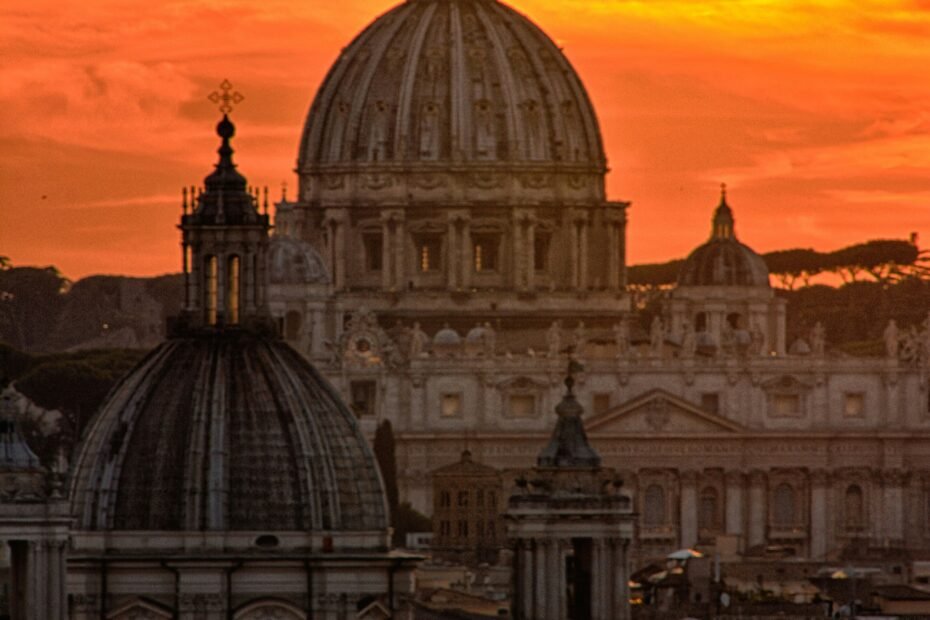St. Peter’s Basilica (Basilica di San Pietro) in Vatican City is one of the most renowned religious and architectural landmarks in the world. It is a masterpiece of Renaissance and Baroque architecture and the center of Roman Catholicism, attracting millions of pilgrims and tourists annually. Here’s a comprehensive guide for visiting:
Overview
- Location: Vatican City, adjacent to St. Peter’s Square.
- Significance:
- Built over the tomb of St. Peter, one of Jesus’s apostles and the first Pope.
- The spiritual heart of the Catholic Church and the site of many papal ceremonies.
- Architecture:
- Designed by some of history’s greatest architects, including Michelangelo, Bernini, and Bramante.
- Its dome dominates the Rome skyline and is one of the largest in the world.
What to See Inside
- The Facade:
- Designed by Carlo Maderno, it measures 114 meters wide and 45 meters tall.
- Features statues of Christ, John the Baptist, and 11 apostles.
- The central balcony, Loggia of the Blessings, is where the Pope gives the “Urbi et Orbi” blessing.
- The Dome:
- Designed by Michelangelo and completed by Giacomo della Porta.
- Interior Height: 136 meters (446 feet), making it one of the tallest domes in the world.
- Climb to the top (via 551 steps or an elevator) for breathtaking views of Vatican City and Rome.
- Interior Highlights:
- The Baldachin (Baldacchino):
- A monumental bronze canopy over the main altar, designed by Bernini.
- Stands 30 meters tall and symbolizes the Church’s grandeur.
- The Papal Altar and Confessio:
- Located above St. Peter’s tomb; only the Pope celebrates Mass here.
- St. Peter’s Chair (Cathedra Petri):
- A relic encased in a sculptural masterpiece by Bernini.
- The Pietà:
- Michelangelo’s famous sculpture of Mary cradling the body of Christ, is located in the first chapel on the right.
- Statues and Monuments:
- Numerous sculptures and tombs of popes, including the elaborate tomb of Pope Alexander VII by Bernini.
- Mosaics:
- The interior is adorned with intricate mosaics, as no paintings were used.
- The Baldachin (Baldacchino):
- The Grottoes:
- Located beneath the basilica, housing chapels and tombs of numerous Popes, including St. Peter’s tomb.
- The Necropolis (Scavi Tour):
- An archaeological site under the basilica where you can see the ancient burial ground and the presumed tomb of St. Peter.
- Requires advance booking and special permission.
St. Peter’s Square
- Designed by Gian Lorenzo Bernini in the 17th century.
- Features:
- Colonnades: Four rows of 284 Doric columns create a welcoming embrace for visitors.
- Obelisk: A 25.5-meter Egyptian obelisk at the center, brought to Rome by Emperor Caligula.
- Fountains: Two fountains by Carlo Maderno and Bernini.
- Papal Audience: Open-air masses and audiences with the Pope are held here.
How to Visit
- Entrance:
- The basilica is free to enter, but expect long security lines at St. Peter’s Square.
- The dome and necropolis require separate tickets.
- Tickets and Tours:
- Dome Climb: €10 for the elevator (partial ascent) or €8 for stairs only.
- Scavi Tour: Approximately €13; must book months in advance through the Vatican’s official website.
- Guided tours of the basilica are available and provide historical and architectural insights.
- Opening Hours:
- Basilica: 7:00 AM – 7:00 PM (April to September); 7:00 AM – 6:30 PM (October to March).
- Dome: 7:30 AM – 6:00 PM (April to September); 7:30 AM – 5:00 PM (October to March).
- Mass Schedule:
- Daily Mass is held in various languages; check the Vatican website for specific times.
Tips for Visiting
- Arrive Early:
- Avoid crowds by arriving early in the morning or late afternoon.
- Dress Code:
- Modest clothing is required (no shorts above the knee, sleeveless tops, or revealing outfits).
- Photography:
- Allowed inside the basilica but prohibited in the grottoes and Scavi area.
- Accessibility:
- Wheelchair accessible with ramps and elevators for most areas.
- Bring Essentials:
- Comfortable walking shoes, sunscreen, and water, especially during peak tourist seasons.
Getting There
- By Metro:
- Take Line A to Ottaviano or Cipro station, then walk 5–10 minutes to St. Peter’s Square.
- By Bus:
- Routes #49, #64, and #492 stop near the basilica.
- By Taxi:
- Taxis can drop you off near the square, but traffic can be heavy.
Best Time to Visit
- Spring and Fall:
- Enjoy pleasant weather and smaller crowds.
- Religious Events:
- Christmas, Easter, and other major Catholic celebrations are spectacular but crowded.
- Wednesday Papal Audience:
- Held in St. Peter’s Square or the Paul VI Audience Hall (requires free tickets).
Nearby Attractions
- Vatican Museums and Sistine Chapel:
- Accessible via a 10-minute walk; home to Michelangelo’s famous ceiling fresco.
- Castel Sant’Angelo:
- A 15-minute walk offering views of the Tiber River and Roman history.
- Borgo Pio:
- A charming area near the basilica with restaurants and shops.
Fun Facts
- St. Peter’s Basilica is the largest church in the world, with a capacity of over 60,000 people.
- Michelangelo was 72 when he began designing the dome.
- It’s said that if you stand in a specific spot in the colonnade of St. Peter’s Square, the rows of columns appear as a single line.
- The bronze for Bernini’s Baldachin came from the roof of the Pantheon.
Cultural and Religious Importance
- St. Peter’s Basilica is a pilgrimage site for Catholics worldwide and a monumental symbol of the Church’s history and artistry.
- It embodies the fusion of faith, history, and architectural innovation, making it a must-visit destination for tourists of all backgrounds.
Conclusion
St. Peter’s Basilica is more than just a church; it’s a treasure trove of art, history, and spiritual significance. From Michelangelo’s Pietà to the majestic dome views, every corner offers something extraordinary. Whether you’re drawn by faith, art, or history, a visit to this iconic site is an unforgettable experience.
